Datalinks
LOS
Amount of data sent via radiolink
Regardless of the radio used, the amount of telemetry data that can be sent by radiolink is limited.
Important
Refer to the Data Transmission section of the 1x Software Manual for information on the amount of data that can be sent.
Digi radio (as internal radio)
Internal Digi radios can establish communication between Veronte Autopilots 1x.
The necessary configuration of Digi radios for proper communication between them and 1x is described in the Digi internal radio - Integration examples section of the 1x PDI Builder manual.
DTC (Domo Tactical) radio (SOL8SDR-C model)
System Layout
It is possible to operate DTC radios in two different ways, with or without amplifiers.
-
DTC
The following image shows the standard connection between DTC radios and Autopilot 1x for operation:

DTC radios and Autopilot 1x operation -
DTC + Amplifier
Note
Amplifier information: AMPD5W model, 5W Linear RF Power Amplifier.
The following image shows the standard connection between DTC radios, amplifiers and Autopilot 1x for operation:

DTC + amplifier radios and 1x operation
Hardware Installation
Depending on the action to be taken, different hardware installations are possible:
-
To configure a DTC radio it is required to carry out the installation of the ethernet and power connection:

DTC D1804 Gecko breakout PCB -
Ethernet

RJ45 pinout T-568B J4 (Ethernet) - D1804 Gecko breakout PCB RJ45 Connector (T-568B) PIN Signal PIN Signal Color Code 1 Ethernet MDIP0 1 TX+ Orange-White 2 Ethernet MDIN0 2 TX- Orange 3 Ethernet MDIP1 3 RX+ Green-White 4 Ethernet MDIN1 6 RX- Green -
Power supply

Female DC Power Jack connector J2 (PWR) - D1804 Gecko breakout PCB Power Connector PIN Signal Signal 1 VIN Power + 2 VIN 3 GND Power - 4 GND
The full connection should look like this:

DTC connection - Configuration -
-
To configure a DTC + amplifier radio it is required to carry out the installation of the ethernet, power and amplifier connection:

DTC D1806 Gecko active breakout PCB -
Ethernet

RJ45 pinout T-568B J4 (Ethernet) - D1806 Gecko Active Breakout PCB RJ45 Connector (T-568B) PIN Signal PIN Signal Color Code 1 Ethernet MDIP0 1 TX+ Orange-White 2 Ethernet MDIN0 2 TX- Orange 3 Ethernet MDIP1 3 RX+ Green-White 4 Ethernet MDIN1 6 RX- Green -
Power supply

Female DC Power Jack connector J2 (PWR) - D1806 Gecko Active Breakout PCB Power Connector PIN Signal Power Signal 1 VIN Power + 2 VIN 3 VIN 4 VIN <5 VIN 6 VIN J9 (GND) - D1806 Gecko Active Breakout PCB Power Connector PIN Signal Power Signal 1 GND Power - 2 GND 3 GND 4 GND 5 GND 6 GND -
Amplifier

Amplifier AMPD5W J8 (AMP) - D1806 Gecko Active Breakout PCB AMPD5W Connector PIN Signal PIN Signal 1 5V_SDA 6 5V_SDA 2 GND 3 GND 4 5V_SCL 5 5V_SCL 7 PA_TDD 7 PA_TDD J2 (PWR) - D1806 Gecko Active Breakout PCB AMPD5W Connector PIN Signal PIN Signal 1 VIN 1 & 2 Power + 2 VIN 3 VIN 4 VIN 5 VIN 6 VIN J9 (GND) - D1806 Gecko Active Breakout PCB AMPD5W Connector PIN Signal PIN Signal 1 GND 3 & 4 Power - 2 GND 3 GND 4 GND 5 GND 6 GND
The full connection should look like this:

DTC + amplifier connection - Configuration -
-
To connect a DTC radio to a Veronte Autopilot 1x the following installation must be carried out:
As, the connection of a DTC radio to a Veronte Autopilot 1x must be made via RS-232, the connection will be the same as in the configuration case (1), but adding the wiring to RS-232 port.

DTC D1804 Gecko breakout PCB - J3 (RS232) This RS-232 should be connected to the RS-232 of Autopilot 1x harness.

J3 (RS232) pinout of female connector 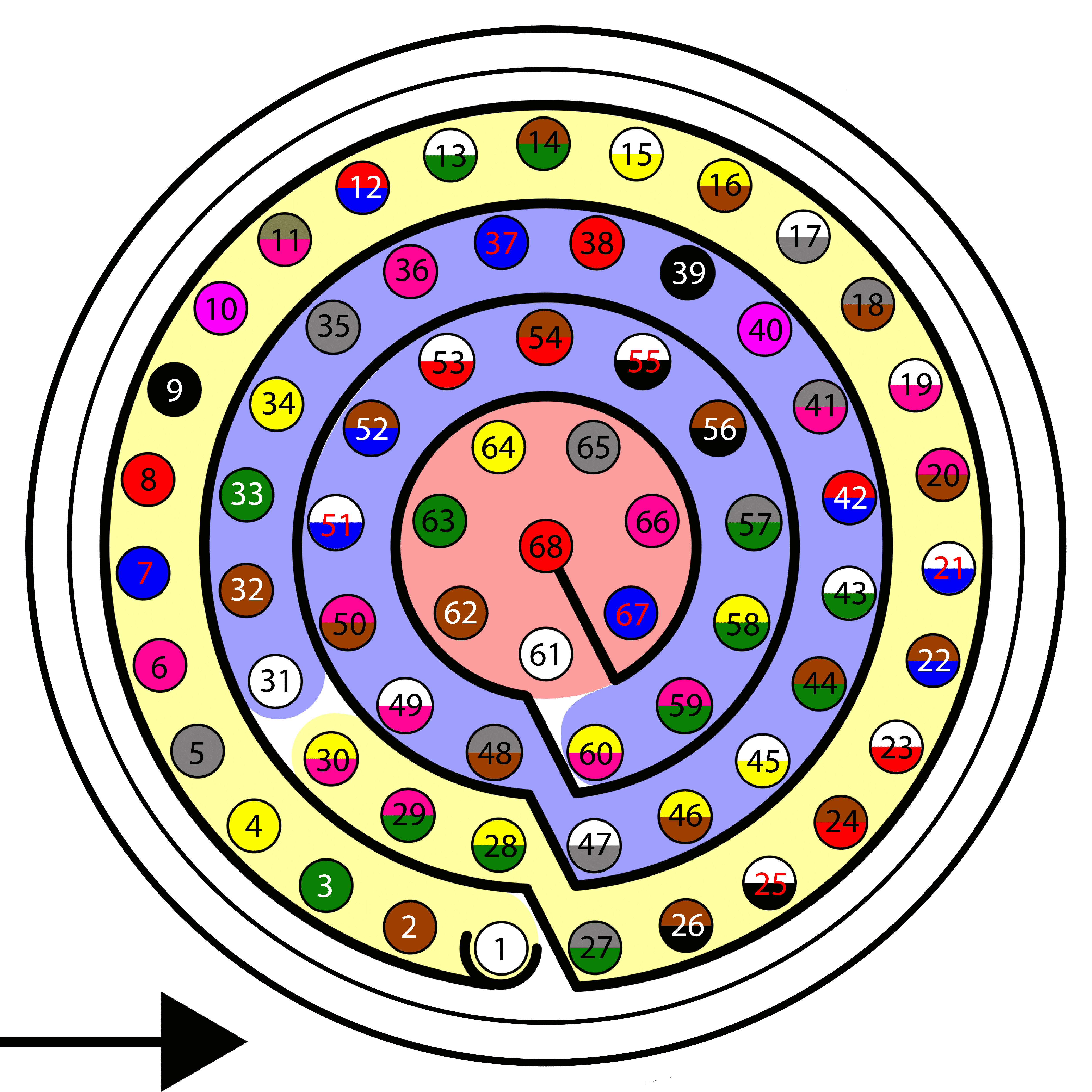
Autopilot 1x harness pinout J3 (RS232) - D1804 Gecko Breakout PCB Autopilot 1x Harness PIN Signal PIN Signal Color Code 2 RS232 RX 19 RS232 TX White-Pink 1 RS232 TX 20 RS232 RX Pink-Brown 3 GND 21 GND White-Blue The full connection should look like this:

DTC connection - Veronte Autopilot 1x -
To connect a DTC + amplifier radio to a Veronte Autopilot 1x the following installation must be carried out:
As, the connection of a DTC radio to a Veronte Autopilot 1x must be made via RS-232, the connection will be the same as in the configuration case (2), but adding the wiring to RS-232 port.

DTC D1806 Gecko active breakout PCB - J3 (RS232) This RS-232 should be connected to the RS-232 of Autopilot 1x harness.

J3 (RS232) pinout of female connector 
Autopilot 1x harness pinout J3 (RS232) - D1806 Gecko Active Breakout PCB Autopilot 1x Harness PIN Signal PIN Signal Color Code 2 RS232 RX 19 RS232 TX White-Pink 1 RS232 TX 20 RS232 RX Pink-Brown 3 GND 21 GND White-Blue The full connection should look like this:

DTC + amplifier connection - Veronte Autopilot 1x
Caution
It is also possible to calibrate the power output of DTC radios and DTC + amplifier radios.
However, the radios are shipped with a factory calibration, it is strongly recommended to not modify this calibration. If the user wishes to modify it, please contact the support team (create a ticket in the customer's Joint Collaboration Framework; for more information, see Tickets section of the JCF manual).
DTC radio configuration
First steps
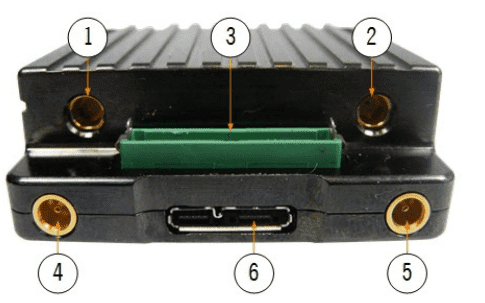
-
DTC without amplifier
- Connect to
 an SMP to SMA RF cable (this is the default transmit output).
an SMP to SMA RF cable (this is the default transmit output). - Connect this SMA RF cable to a 2.4 GHz antenna.
- Connect to
 the D1804 Gecko breakout PCB supplied with the unit.
the D1804 Gecko breakout PCB supplied with the unit. - Connect J2 (PWR) of the D1804 PCB to 12V power.
-
In order to access the web browser control application, connect J4 (ETHERNET) of the D1804 PCB to a PC or network Ethernet port via CA2856 and D918.
Note
The connections should look like this:

First steps connection
-
Make sure computer is set to static IP address on same subnet as radio. The following substeps clarify how to set the IP address in the Control Panel:
-
Open Network and Sharing Centre menu and click Change adapter settings.

Ethernet connection 1 -
Select Local Area Connection, right click, and select Properties.

Ethernet connection 2 -
Select IPv4 and click Properties.

Ethernet connection 3 -
Set IP address to 192.168.8.YY (e.g. if the IP of the radio is 192.168.8.95, set the IP 192.168.8.92) and Subnet mask to 255.255.255.0. Click OK.

Ethernet connection 4
-
-
First, it is necessary to have the 'Domo Node Finder' software installed.
-
Open Domo Node Finder and the connected radios will appear here as SOL8SDR.
By default, 0.0.0.0 is the IP address of the radio:

Domo Node Finder - Default IP address -
To configure the IP address, right-click the IP address and select Configure Network to disable the DHCP setting and set the following static IP address:

Domo Node Finder - IP address configuration To confirm the change, click the
 icon to update the IP address.
icon to update the IP address.
Domo Node Finder - Configured IP address Note
This IP address, 192.168.8.95, is related to the radio linked to the ground unit. For the radio linked to the air unit, the IP address should be 192.168.8.96.
-
To open the DTC web browser control application, users can right-click the IP address and select WEB Interface (HTTP port 80), double-click on the IP address or enter the IP address of the SOL8SDR-C on the address bar of a web browser.

Domo Node Finder - Open Web Browser Application Note
Although the application should work with any web browser, DTC recommends the use of Internet Explorer, Google Chrome or Firefox.
-
An authentication required dialogue box will open. Leave the Username blank and enter the Password as Eastwood.

Domo Node Finder - Open Web Browser Application -
Click Login and the web browser control application will open.
- Connect to
-
DTC with amplifier
- Connect to
 an SMP to SMA RF cable (this is the default transmit output).
an SMP to SMA RF cable (this is the default transmit output). - Connect this SMA RF cable to the amplifier RF IN port.
- Connect a 2.4 GHz antenna to the amplifier RF OUT port.
- Connect to
 the D1806 Gecko active breakout PCB.
the D1806 Gecko active breakout PCB. - Connect J4 (ETHERNET) of the D1806 PCB to a PC or network Ethernet port via CA2856 and D918.
- Connect J2 (PWR) and J9 (GND) of the D1806 PCB to 12V power.
-
Connect J8 (AMP) of the D1806 PCB to the control cable from the amplifier connector.
Note
The connections should look like this:

First steps connection + amplifier -
Now the steps to follow are the same as from step 6. of a DTC without amplifier, described above.
- Connect to
Point-to-Point configuration
-
Basic radio configuration
Once the website has been accessed, follow the steps below which show the parameters that need to be modified for a correct operation and pairing of the radios.
Note
This is an example of the radio configuration linked to a ground unit.
Note
After making any changes, the application will 'ask' to Save or Cancel the changes. An example is shown below:

Save or Cancel changes -
Global Setup General Settings: To easily identify each radio in a mesh, the user can rename the radio as desired:

General settings configuration Note
The radio related to the air unit also has its own customized name:

General settings air configuration -
Presets.
-
Mesh Settings: Some of the parameters configured in this menu are always displayed at the top of the application.
Caution
It is recommended that software for all devices in a Mesh network should be at the same version to avoid potential compatibility issues.

Mesh settings configuration - Operation mode: Select Single Mesh.
-
Mesh ID: The Mesh ID must be the same on all units in the Mesh network. The Mesh ID tells the unit which network it belongs to, for example, all NETNodes on Mesh ID 1 will communicate with each other. The Mesh ID must be set to a non-zero value.
-
Node Id: The node ID must be unique in the Mesh network for each device.
Note
A node can automatically reassign its Node ID at power up if it finds a conflict with an existing node.
-
Operating range: A larger range allows the Mesh network to operate over a bigger distance at the expense of bitrate.
- Enable transmitter: Set the checkbox to switch the RF power on.
-
Frequency: Set the desired transmission frequency. 2450 MHz recommended.
Warning
Be careful when choosing the frequency. The user may see interference with the Wifi frequency band, consult the radio spectrum.
-
Channel bandwith: Select the desired bandwidth from the drop-down list. Lower bandwidths provide greater range at the expense of data throughput. 10 MHz is recommended.
- Output attenuation: The level of attenuation in dB that is applied to the output (from 0 to 32). 0 dB of attenuation is recommended
- RF output port: The transmitter has two COFDM antennas, A and B. A is selected as the output antenna by default, but the user can select A or both if required.
-
PA linearity: High linearity improves the COFDM shoulder performance at the expense of power consumption.
Usually used when working with power amplifiers which must have excellent shoulder performance to operate, or for improved adjacent channel performance.
Warning
To ensure proper communication between the two radios, the radio linked to the air unit must have these same 'Mesh settings' except for the Node Id, as each node in the mesh has its own Id (starting with Id 0):

Mesh settings air configuration
Moreover, there are up to 16 different preset configurations that can be setup.
All these settings are made for preset 1, which is highlighted with a blue background in the 'Mesh settings' tab to indicate that it is active.
In addition, a 'preset indicator' with the current present is always displayed at the top right of the application, as shown in the figure below.

Current preset configuration -
Unit Settings:
External Power Enable: There is an external power output which can be used to supply 12VDC (1A) to an external device.
This could be a camera, GNSS antenna or other device.

Unit settings configuration
-
-
Data RS232 #1: In this menu the parameters of the RS232 port and the network settings are configured:

RS232 #1 configuration -
Data mode: UDP option is recommended. UDP packets are sent out and the system does not expect a reply. There is no way that the sending device can tell if the data arrived at the destination.
-
The value of the Baud rate, Parity and Stop Bits parameters must be the same as those configured in 1x PDI Builder.
Note
The data is assumed to be 8 bits.
-
Low latency: Low latency will minimise delay at the expense of bitrate, so if set, data tranfer will be less prone to bursts. Yes is recommended.
-
IP address: This should be the address of the radio receiving the data on the other end of the RS-232.
In this case, as the radio connected to the ground unit is being configured, the IP of the radio linked to the air unit will be set.
-
IP port: This set an IP port to and from which the data will be transferred. It must be the same for both radios.
Important
For the radio connected to the air unit, the IP address to be configured is the address of the radio linked to the ground unit.

RS232 #1 air unit configuration -
-
System Maintenance: This menu allows to import and export radio configurations.

Maintenance configuration To import a configuration into the radio, it is first necesarry to choose a configuration from the local storage by clicking on the
 icon.
Then, the 'import button' will already be available (colored in blue) to click on and consequently import the selected configuration. An example is shown below:
icon.
Then, the 'import button' will already be available (colored in blue) to click on and consequently import the selected configuration. An example is shown below:
Configuration selected
-
-
Paired radios
Once both radios have been configured with these settings, they should be paired. Therefore, if we connect them to the power supply and only one of them to the computer, we can access the Domo Node Finder software or directly the Web Browser control application to check if they are correctly paired.
-
Domo Node Finder software
When 2 radios are paired, they will both appear here:

Domo Node Finder - Radios paired As can be seen in the figure above, the connection type of each radio is indicated with different icons:
 icon for the radio that is wiredly connected to the PC.
icon for the radio that is wiredly connected to the PC. icon for the radio that is connected by link.
icon for the radio that is connected by link.
-
Web Browser control application
When two radios are paired, this can be seen/checked directly in the 'Dashboard' of both radios.

Radios paired - Dashboard Furthermore, it can be seen that the above figure is related to the radio that is connected by link, as it is indicated at the top of the application with the label Over radio link.
-
Apps Tactical Display: Here the user can check the connection and the quality of the signal connection of both radios:

Radios paired - Tactical Display -
Map display: The color of the link between nodes indicates the quality of the signal. The colors range from green (reliable link) to red (unreliable link). If no link is displayed, it means that communication has been lost.
-
TX info: TX info should be selected to check the quality of the signal connection.
-
Token Tx retries: In a Mesh network, transmission is arbitrated by passing a token between nodes. This tab displays the number of token retries that have been needed for each node. It must be 0 with occasional 1 for a proper communication.
Caution
Higher values will have an undesirable effect on system performance. If problems occur, check for interference and that there is no other Mesh system operating on the same or adjacent frequency.
-
-
-
-
Point-to-Multipoint configuration
It is possible that the user wants to make a point-to-multipoint radio connection, i.e. there will be one radio sending commands to several radios, so there will be at least 3 radios.
The following is the configuration required for this type of connection.
-
Radio configuration
The modifications to be made to the basic configuration explained above for the point-to-point application are detailed below.
Note
This example has been made with 3 radios (3 nodes in a mesh).
-
Presets Mesh Settings: The Node ID must be different for each node in the mesh.

Mesh settings ground configuration 
Mesh settings air configuration 
Mesh settings base configuration In the figures above, the user can see that the node ID is displayed at the top of the application at all times.
-
Data RS232 #1: The Multicast data mode must be configured. This data mode allows a single node to send RS232/RS485 data to multiple nodes in the system. And it also creates a unicast data return channel. The radio linked to the ground unit is configured as the 'Point' that sends the commands.

RS232 #1 ground configuration - Data mode: Multicast source must be selected.
- IP address: To send the data to all receivers the IP address must set to 255.255.255.255.
-
Multicast address: It must be the same for all radios, avoiding the 244.0.0.X address range.
The address must be different from any multicast streaming and data channels.
Then, the radios linked to the air and base units receive those commands:

RS232 #1 air unit configuration 
RS232 #1 base unit configuration - Data mode: Multicast sink must be selected.
- IP address: The IP address of the radio linked to the ground unit is set.
-
Multicast address: It must be the same for all radios, avoiding the 244.0.0.X address range.
The address must be different from any multicast streaming and data channels.
-
-
Paired radios
Once the radios have been configured with these settings, they should be paired. Therefore, if we connect them to the power supply and only one of them to the computer, we can access the Domo Node Finder software or directly the Web Browser control application to check if they are correctly paired.
-
Domo Node Finder software
When 3 radios are paired, they will appear here:

Domo Node Finder - 3 radios paired As can be seen in the figure above, there is 1 radio wiredly connected to the PC and 2 radios connected by link.
-
Web Browser control application
When 3 radios are paired, this can be seen/checked directly in the 'Dashboard' of the three radios.

Radios paired - Dashboard Furthermore, it can be seen that the above figure is related to a radio that is connected by link, as it is indicated at the top of the application with the label Over radio link.
-
Apps Tactical Display: Here the user can check the connection and the quality of the signal connection of the radios:

Radios paired - Tactical Display
-
-
For more information on the configuration of DTC radios, please refer to the DTC documentation.
DTC radio configuration in 1x PDI Builder
The necessary configuration of DTC radio in 1x PDI Builder is described in the External radios - Integration examples section of the 1x PDI Builder manual.
Microhard pDDL900-ENC external
System Layout
It is possible to operate Microhard radios in two different ways, with or without amplifiers.
-
Microhard
The following image shows the standard connection between Microhard radios and Autopilot 1x for operation:

Microhard radios and Autopilot 1x operation -
Microhard + Amplifier
Note
Amplifier information: DDL900 Amplifier model, 10W Linear Amplifier.
The following image shows the standard connection between Microhard radios, amplifiers and Autopilot 1x for operation:

Microhard + amplifier radios and Autopilot 1x operation
Hardware Installation
First, it is necessary to carry out the wiring of the power connector with the 4-pin power cable supplied with the Microhard radio and with the power connector of the amplifier:

| Power Jack Connector | |||
|---|---|---|---|
| PIN | Signal | Signal | |
| RADIO | RED | Vin+ 9-30V | Power + |
| AMPLIFIER | 1 | DC 24-30V | RADIO | BLACK | Vin- | Power - |
| AMPLIFIER | 2 | GND | |
Danger
The specified supply voltage range for Microhard radios + amplifier is different from that of just Microhard radios. Please take this into account when powering.
Then, to physically connect the Microhard radio to Veronte Autopilot 1x for operation, connect an RS-232 connector between the RS-232 port of the radio and the RS-232 of Autopilot 1x harness.


| Serial port - Microhard radio | Autopilot 1x Harness | |||
|---|---|---|---|---|
| PIN | Signal | PIN | Signal | Color Code |
| 2 | RXD | 20 | RS 232 RX | Pink-Brown |
| 3 | TXD | 19 | RS 232 TX | White-Pink |
| 5 | GND | 21 | GND | White-Blue |
Microhard radio configuration
First steps
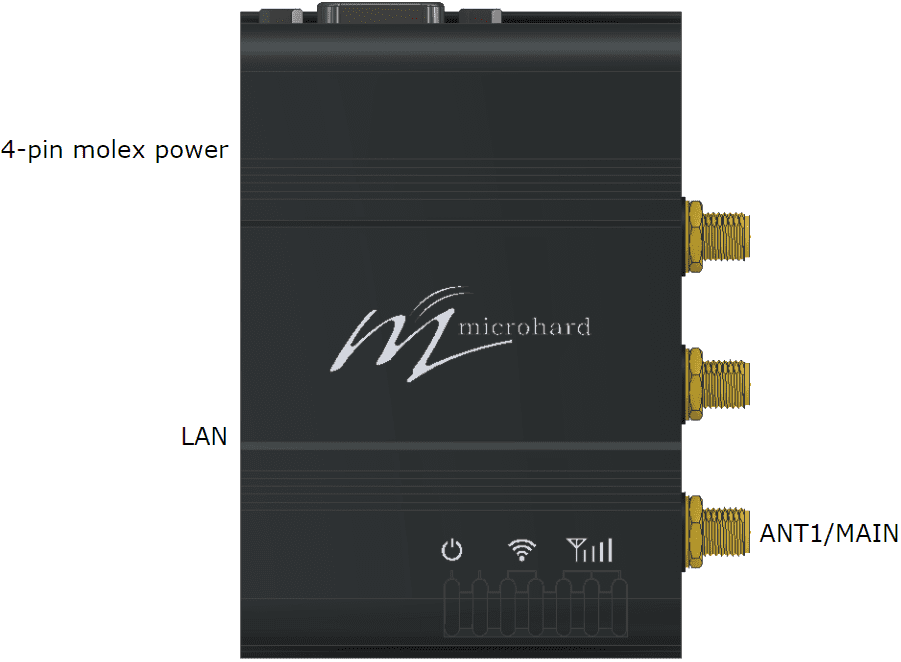
-
Microhard without amplifier
- Connect a suitable 900 MHz antenna to the ANT1/MAIN connector.
- Connect to the 4-pin molex power connector the 4-pin power cable supplied with the unit.
-
Connect the power connector that has been previously wired with the cable to either 12V or 24V power.
Then, once the radio is fully booted, the Power LED indicator (the one next to the power symbol) will be solid blue.
-
To access the radio's WebUI for configuration, connect the LAN port (not the WAN port) to a PC, using an Ethernet cable.
The connections should look like this:

First steps connection -
To open the Microhard WebUI, open a browser and enter the IP address of the radio into the address bar.
Note
If users have problems accessing the Microhard radio WebUI, it may be because the PC's network connection settings (IP address and subnet of the adapter) are not configured properly. For further details, consult Microhard radio troubleshooting section below.
-
The website will then ask for a Username and Password. Enter the factory defaults:
- Username: admin
- Password: admin

Open WebUI -
Click Sign In and the WebUI will open.
- Once successfully logged in for the first time, the WebUI will force a password change.
-
Microhard with amplifier

Amplifier ports - Connect to the ANT1/MAIN connector of the radio a SMA RF cable.
- Connect this SMA RF cable to the amplifier RADIO port. Connect a suitable 900 MHz antenna to the amplifier ANTENNA port.
- Connect to the 4-pin molex power connector of the radio the 4-pin power cable supplied with the unit.
- Plug to the POWER port of the amplifier, the power connector supplied with it.
-
Connect the power connector that has been previously wired with the radio cable and the amplifier connector to 24V power.
Then, once the radio is fully booted, the Power LED indicator (the one next to the power symbol) will be solid blue.
-
Now the steps to follow are the same as from step 4. of a Microhard without amplifier, described above.
The connections should look like this:

First steps connection + amplifier
For more information on the configuration of Microhard radios, please refer to the Microhard documentation.
Basic radio configuration
Once the website has been accessed, follow the steps below which show the parameters that need to be modified for a correct point-to-point configuration and pairing of the radios.
Important
This example describes the parameters to be entered for both the radio linked to the 1x ground unit and the radio linked to the 1x air unit.
If the values are common to both radios configurations, only one of them will be detailed.
Note
After making any changes, the application will 'ask' to Submit or Cancel the changes. An example is shown below:

-
System
-
Maintenance: From this menu, users can export (backup) and import (restore) configurations.
- Backup Configurations: The radio configuration can be backed up to a file at any time using the Backup Configuration feature.
- Restore Configurations: Using this option, a previously 'backed up' configuration can be uploaded to the radio.
Note
A password can be added to backup and restore files. If the password is lost, files that have been backed up with a password cannot be restored.

System Maintenance To import (restore) a configuration into the radio, it is first necessary to choose a configuration from the local storage by clicking on
Choose File.Then, once the configuration is loaded, click on the
Check Configuration Filebutton.
System Maintenance - Restore Configuration 1 After that, if the file is correct, a new window will appear to restore this configuration.

System Maintenance - Restore Configuration 2 Finally, the WebUI will reloaded to applied the configuration.

System Maintenance - Restore Configuration 3 Error
If the restored configuration has a different IP address assigned to the radio, users may have to change again the adapter settings on the PC to be able to access the WebUI with the new IP address of the radio.
-
Summary: This screen is displayed immediately after the initial login, showing a summary and status of all radio functions on a single display.
This information includes system status, LAN network information and settings, version information, radio connection status, etc.

System Information -
Settings: To easily identify each radio in a mesh, the user can rename the radio as desired by configuring the Host Name and Description parameters:

System Settings - GND unit 
System Settings - Air unit
-
-
Network LAN: Ethernet LAN port of the radio is for connecting devices to a local network.
By default, this port has a static IP address, and also, it is running a DHCP server to provide IP addresses to devices that are connected to the physical LAN port (directly or through a switch).

LAN Interfaces Settings By selecting the
EditorAddbuttons, the LAN network interface can be configured or additional LAN interfaces can be created.LAN Configuration:

LAN Configuration - Ground unit 
LAN Configuration - Air unit -
Connection Type: To determine whether the radio will obtain an IP address from a DHCP server on the connected network or whether a static IP address will be entered. Select the Static IP option for this point-to-point configuration.
Since the Static IP option has been chosen, the following fields must also be entered.
-
IP Address: A valid IPv4 address for the network used must be entered in this field.
- For the radio linked to the ground unit 192.168.8.4 has been entered.
- For the radio linked to the air unit 192.168.8.5 has been entered.
-
Netmask: The Network Mask for the network must be entered. The default netmask 255.255.255.0 is normally left.
-
Default Gateway: If the radio is integrated into a network that has a defined gateway, then, as with other hosts on the network, the IP address of this gateway will be entered in this field.
In case the user is using a PCS, 192.168.8.1 should be set here.
-
Default Route: This parameter allows the user to set this interface as the default route in the routing table.
In cases where the LAN is the primary connection, this would be set to Yes.
Important
Once the IP Address has been changed, users will have to type the new address in the browser in order to continue with the configuration.
LAN DHCP: A radio can be configured to provide Dynamic Host Control Protocol (DHCP) service to all connected devices (wired or wireless).

LAN DHCP -
DHCP Server: Enables/Disables the DHCP service for devices connected to the LAN port. Therefore, devices that are connected to the physical Ethernet LAN ports will be assigned an IP by the radio.
Caution
Before enabling this service, check that there are no other devices, either wired or wireless, with an active DHCP Server service.
Hint
At this point, if Enabled and if users have previously set the PC to the static IP address on the same subnet of the radio, they can now change the adapter settings back to "Obtain an IP address automatically". Consequently, users will no longer have to change this setting on the PC every time they want to access the radio's WebUI.

Adapter settings - IP address automatically -
Start IP Address: Select the starting DHCP address from which IP addresses will be assigned. The first octets of the subnet will be pre-set based on the LAN IP configuration, and cannot be changed. We enter here 192.168.8.100.
-
Number of Address: Set the maximum number of IP addresses that can be assigned by the radio. By default, 150 (this is an integer value).
-
Lease Time (in minutes): The DHCP lease time is the amount of time before a new request for a network address must be made to the DHCP Server. Defaults to 720 minutes.
-
-
Wireless RF: Allows to configure the radio module.
Important
Ensure that the RF Band, Channel Bandwidth and Frequency-Channel are set the same on each module.

Wireless Configuration - Ground unit 
Wireless Configuration - Air unit RF Configuration:
- Radio: Turns the radio module on/off.
- RF Band: Select the desired RF band to work, 900 MHz or 2.4 GHz. In this case, we select 900 MHz.
-
Channel Bandwidth: Select the channel bandwidth from the list. Generally a larger channel has higher throughput, at the cost of sensitivity, while a smaller channel tends to be more robust, but at the cost of throughput. 1 MHz is recommended.
Caution
Refer to the radio specifications (Microhard documentation) in order to see the relationship and performance between channel bandwidth, throughput and sensitivity.
-
900 MHz Channel: Set the Channel-Frequency. The frequency displayed is the center frequency and is available in 1 MHz increments. The values shown will vary with the Channel Bandwidth selected above. 13-915 MHz is recommended.
Important
- This value must be the same on each unit in a network.
- The noise floor of the specified channel will dramatically affect the link quality, it is essential to select the cleanest channel for superior performance.
-
Tx Power: This setting establishes the transmit power level that will be presented to the antenna connector of the radio. Select 30 dbm here.
Caution
For bench or proximity testing, it is best to use a lower power setting to avoid RF saturation.
-
Wireless Distance: This parameter allows users to set the expected distance the wireless signal should travel.
The radio sets various internal timeouts to account for this travel time. Longer distances will require a higher setting, and shorter distances may work better if the setting is reduced. 3000 m is set.
-
Operation Mode: A radio in Master mode can provide a wireless data connection to multiple slaves/remotes.
And, in Slave mode, it can maintain a wireless connection, i.e. to a Master.
- For the radio linked to the ground unit Master mode must be selected.
- For the radio linked to the air unit Slave mode must be selected.
-
TX Rate: This setting determines the type of modulation and, in turn, the rate at which the data will be transferred wirelessly.
The default and recommended setting for both Master and Slave units is 'Auto'.
In 'Auto', the unit will transfer data at the highest possible rate depending on the receiving signal strength (RSSI).
-
Network ID: Each radio module network must have a unique Network ID. In this case, pDDL has been entered.
Important
This Network ID must be configured the same in each unit on the network.
RF Serial Port Configuration:
- Serial Port TX Rate: When using Ethernet and Serial data,
- If the volume of serial data is high Normal Rate (default option)
- If the volume of Ethernet data is high High Rate (compressed).
-
Serial Settings: This menu allows configuring the serial device server for the serial communications port. Data from the serial device can be brought into the IP network via TCP, UDP or multicast; it can also come out of the radio network on another radio serial port.
Port Configuration:

Port Configuration - Ground unit 
Port Configuration - Air unit - Port status: Select the operating state of the serial port. By default, Data.
- Port Mode: RS232 must be selected.
-
Data Baud Rate: The serial baud rate is the rate at which the modem should communicate with the connected local asynchronous device.
Important
It must match the one configured in the 1x PDI Builder software 115200.
-
Data Format: This setting determines the format of the data on the serial port. It is the set of Data Bits, Parity and Stop Bits parameters.
Important
It must match those configured in the 1x PDI Builder software 8N1 (8 data bits, No parity, and 1 Stop bit).
-
Data Mode: This setting defines the framing of the serial output data.
- In Transparent mode (default), the received data will exit the radio quickly.
- In Seamless mode, the serial port server will add a gap between data frames to comply with a specified protocol.
In this case, Transparent mode is selected.
-
Character Timeout: Defaults to 24 characters.
-
Maximum Packet Size: Defines the size of the buffer that the serial server will use to receive data from the serial port.
When the server detects that the Character Timeout criterion has been met, or the buffer is full, it packs the received frame and transmits it.
It must be 266, as this is the maximum packet size supported by Veronte Communication Protocol (VCP).
-
IP Protocol Config: This setting determines which protocol the serial server will use to transmit serial port data over the radio network.
- For the radio linked to the ground unit TCP Server.
- For the radio linked to the air unit TCP Client.
TCP Configuration: The protocol selected in the IP Protocol Config field will determine which configuration options appear in this configuration menu.
-
In the TCP Server mode, the radio series will not initiate a session, but will wait for a Client to request a session. The unit will 'listen' on a specific TCP port.
- If a session is established, data will flow from the Client to the Server, and, if present, from the Server to the Client.
- If a session is not established, both Client serial data and Server serial data, if present, will be discarded.

TCP Configuration - Ground unit - Server Mode: Monitor is recommended.
- Local Listening port: The TCP port on which the server listens. Allows a TCP Client to create a TCP connection to transport data from the serial port. 20002 should be set.
- Incoming Connection Timeout (seconds): Establishes when the TCP Server will terminate the TCP connection if the connection is in an idle state. It is recommended 5 seconds.
-
When TCP Client mode is selected and data is received on its serial port, the radio takes the initiative to find and connect to a remote TCP server.
The TCP session is terminated by this same unit when the data exchange session is completed and the connection timeout has expired.
If a TCP connection cannot be established, data is discarded from the serial port.

TCP Configuration - Air unit -
Remote Server IP Address: Enter an IP address of a TCP server which is ready to accept serial port data over a TCP connection.
Users must set the IP adddress of the radio defined as Master, in this case, the IP address of the radio linked to the ground unit 192.168.8.4.
-
Connection status radio
-
Network Status: Provides an overview of the currently configured network interfaces, including the Connection Type (Static/DHCP), IP Address, Net Mask, Default Gateway, DNS, and IPv4 Routing Table.
-
Wireless Status General Status: Shows the MAC address of the current radio, the Operating Mode (Master, Slave etc), the Network ID being used, Channel Bandwidth and Frequency information and the type of security used.
-
Serial Status: This window displays a number of status items that help to visualize the operation, statistics and troubleshooting of the RS232 port.
Note
That is, the connection status with Veronte Autopilot 1x.
- Port Status: Shows whether the RS232 port has been enabled in the configuration.
- Baud Rate: The current baud rate used to interact with the connected device.
- Connect As: This shows the type of IP Protocol Config chosen (TCP, UDP, SMTP, PPP, etc).
- Connect Status: Shows if there is a current connection / if the port is active.
- Receive bytes/packets
- Transmit bytes/packets
In addition, to check the connection status between the Autopilot 1x and the radio, users can simply look at the LED indicators on the radio:
- When the TX LED turns red, that indicates that the modem is transmitting data over the radio.
- When the RX LED turns green, it indicates that the moden is synchronized and has received valid packets.
Paired radios
Once both radios are configured with these settings, they should be paired.
Therefore, by connecting both to the power supply, users can check that they are paired by simply observing the RSSI LEDs, they should be in a solid green. The more LEDs ilumitated the stronger the link.
Moreover, users can access the radio's WebUI to check it in the following menu:
Note
If they are correctly linked, by connecting only one of the radios to the PC, users will be able to access the WebUI of both radios.
Wireless Status: The Status window provides an overview of all wireless or radio settings and connections.
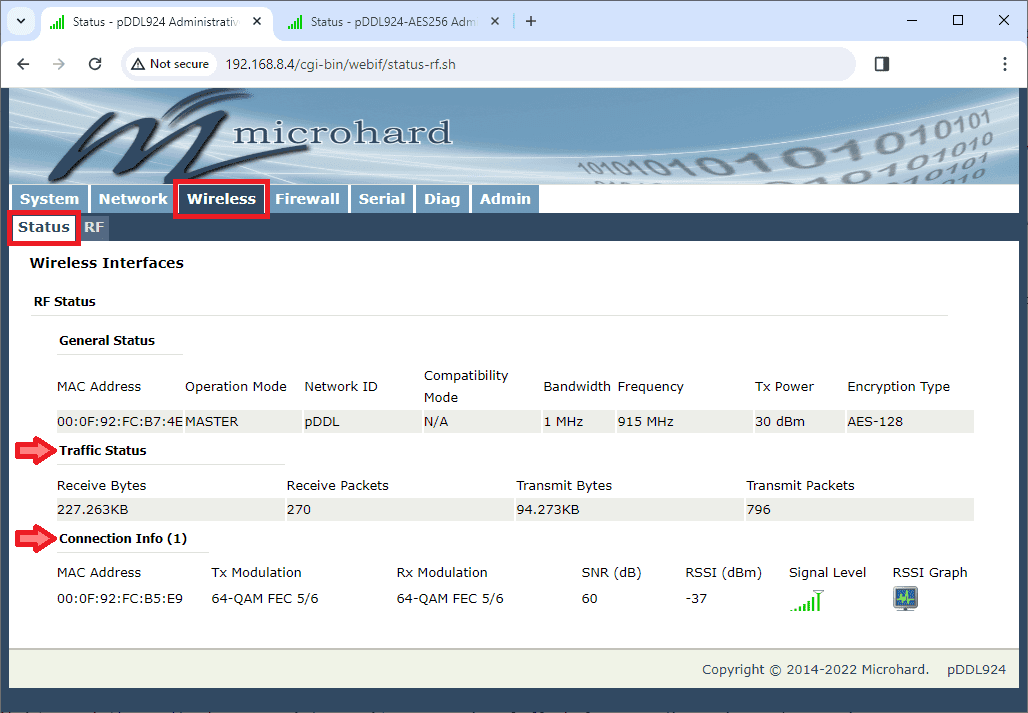
- Traffic Status shows statistics on transmitted and received data.
-
Connection Info displays information about all wireless connections.
The MAC address, TX & RX Modulation, Signal to Noise ratio (SNR), Signal Strength (RSSI), and a graphical representation of the signal level or quality, as well as a RSSI Graph Link. By clicking on
 , a new window with the RSSI Graph Link will be displayed:
, a new window with the RSSI Graph Link will be displayed:
Wireless Status - RSSI Graph Link
Microhard radio configuration in 1x PDI Builder
The necessary configuration of Microhard radio in 1x PDI Builder is described in the External radios - Integration examples section of the 1x PDI Builder manual.
Microhard radio troubleshooting
If the user has problems accessing the radio's WebUI, try setting the computer to the static IP address on the same subnet as the radio.
The following steps clarify how to set the IP address in the Control Panel:
-
Open Network and Sharing Centre menu and click Change adapter settings.

Ethernet connection 1 -
Select Local Area Connection, right click, and select Properties.

Ethernet connection 2 -
Select IPv4 and click Properties.

Ethernet connection 3 -
Set IP address to 192.168.168.YY (e.g. if the IP of the radio is 192.168.168.1, set the IP 192.168.168.10) and Subnet mask to 255.255.255.0. Click OK.

Ethernet connection 4
Silvus radio (StreamCaster 4200E model)
System Layout
The following image shows the standard connection between Silvus radios and Autopilot 1x for operation:
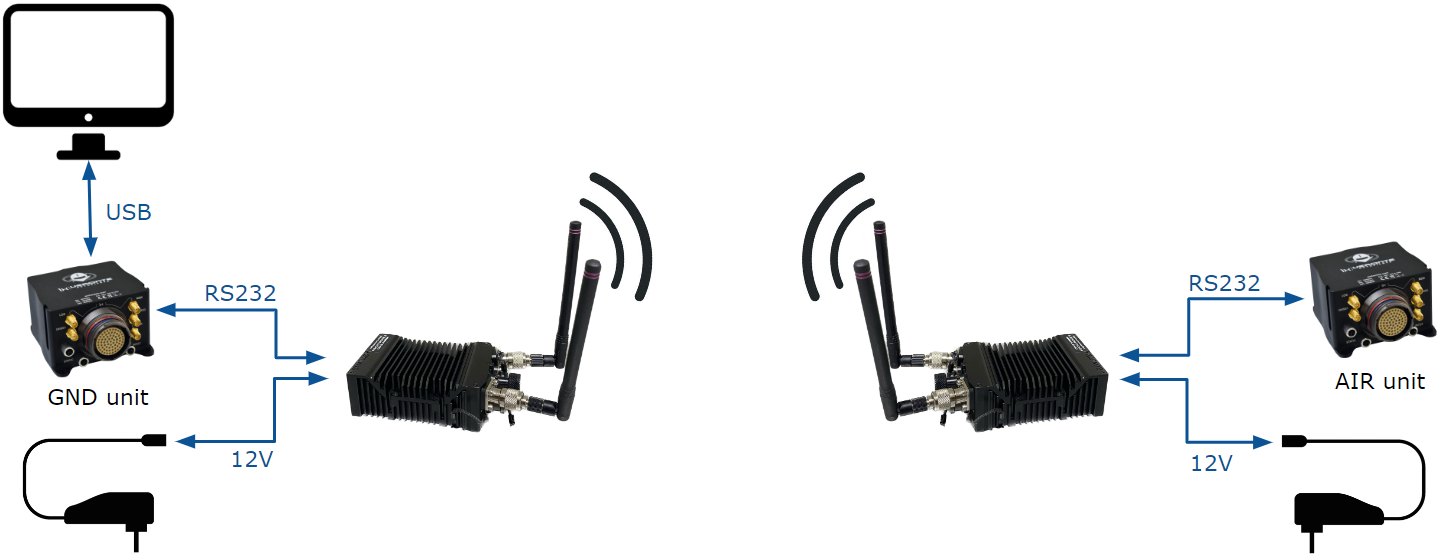
Hardware Installation
A wiring configuration of the PRI cable connected to the PRI port of the radio is required, in order to connect to the power supply, ethernet and RS-232.
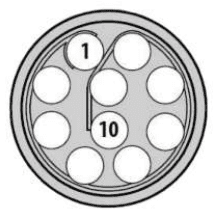
-
Power supply

Female DC Power Jack connector PRI port Connector - Silvus Radio Power Connector PIN Signal Signal 2 GND IN Power - 3 VCC IN Power + -
Ethernet

RJ45 pinout T-568B PRI port Connector - Silvus Radio RJ45 Connector (T-568B) PIN Signal PIN Signal Color Code 4 ETH0_MX2N (RX-) 6 RX- Green 5 ETH0_MX2P (RX+) 3 RX+ Green-White 6 ETH0_MX1P (TX+) 1 TX+ Orange-White 10 ETH0_MX1N (TX-) 2 TX- Orange -
RS-232
The RS-232 from the PRI cable should be connected to the RS-232 of Autopilot 1x harness.

Autopilot 1x harness pinout PRI port Connector - Silvus Radio Autopilot 1x Harness PIN Signal PIN Signal Color Code 7 RS232_RXD 19 RS 232 TX White-Pink 8 RS232_TXD 20 RS 232 RX Pink-Brown 9 GND 21 GND White-Blue
Silvus radio configuration
This section shows a basic configuration of the Silvus radio.
First steps
- Connect antennas (or attenuators) with male TNC ends to 2 RF ports.
- Connect power supply to power port on PRI cable.
-
Connect non-forked female side of PRI cable to radio's PRI port.

Silvus connectors -
When looking at the rotary multi position switch from the top, pull the knob towards you while rotating the knob towards the 1 position.
This turns radio on. LED indicator will turn to fix red.
-
In order to access the StreamScape graphical user interface (GUI), connect Ethernet (RJ45) connector of PRI cable to Ethernet port of laptop/computer.
-
Make sure computer is set to static IP address on same subnet as radio. The following substeps clarify how to set the IP address:
-
Open Network and Sharing Centre menu and click Change adapter settings.

Ethernet connection 1 -
Select Local Area Connection, right click, and select Properties.

Ethernet connection 2 -
Select IPv4 and click Properties.

Ethernet connection 3 -
Set IP address to 172.20.XX.YY (e.g. if the IP of the radio is 172.20.178.203, set the IP 172.20.178.200) and Subnet mask to 255.255.0.0. Click OK.

Ethernet connection 4
-
-
Wait for LED indicator to turn to blinking green.
-
Access StreamScape GUI in web browser. To access, enter IP address of radio into web browser and press enter.
Note
Latest version of Firefox or Google Chrome are preferred. Internet Explorer or others are not recommended.

Silvus initial menu -
User manual can be accessed by clicking the book icon in the GUI (Next to Basic Configuration in the previous screenshot).
Basic radio configuration
Once the website has been accessed, follow the steps below which show the parameters that need to be modified for correct operation and pairing of the radios.
Note
This is an example of the radio configuration linked to a 1x air unit.
Note
After making changes to each window, it is important to click on "Save and apply".
-
Basic Configuration.

Basic configuration panel -
Frequency (MHZ): This defines the frequency of the signal. There is a drop-down menu for frequency selection. We recommend 2220 MHz.
Warning
Be careful when choosing the frequency. The user may see interference with the Wifi frequency band, consult the radio spectrum.
-
Bandwith: This defines the RF bandwidth of the signal. Default value.
-
Network ID: Network ID allows for clusters of radios to operate in the same channel, but remain independent.
A radio with a given Network ID will only communicate with other radios with the same Network ID.
-
Link Distance (meters): Set to an approximate maximum distance between any two nodes in meters. It is important to set the link distance to allow enough time for packets to propagate over the air. It is recommended to set the link distance 10-15% greater than the actual maximum distance.
-
Total Transmit Power (requested): This defines the total power of the signal (power is divided equally between the radio antenna ports).
Set the appropriate power for each application. The power that has been set is small, as it is sufficient for our tests.
-
Routing Mode: As Large Network mode requires a license and is not available outside USA, we set Legacy mode.
-
-
Advanced configuration.

Advanced configuration panel -
Transmit/Receive Channels: Allows user to enable or disable each channel on the radio for TX/RX (each RF port is a channel).
We have enabled both channels.
-
-
Networking. Multicast.

Multicast panel - Default Multicast Algorithm: Broadcast.
- Custom Pruning/Augmenting: Disable.
-
Serial/USB Setup

RS-232 settings - Serial Port Setup: RS-232.
- RS-232 Serial Port Settings
- The value of the Baudrate, Data Bits, Parity and Stop Bits parameters must be the same as those configured in 1x PDI Builder.
- Software Flow Control: Disable.
- Transport Protocol: We recommend UDP. If no data loss can be tolerated, change this setting to TCP on the radio corresponding to the 1x air unit.
- Peer IP: This should be the IP address of the radio on the other end of the RS-232. In this example, we must set the IP address of the radio linked to the ground unit.
Note
Both radios (the one connected to the GND unit and the one connected to the AIR unit) have the same configuration except for the Peer IP.

In addition to these settings, different configurations can be stored in the same radio, on the Multi-Position Switch panel. The user can select the one that will work, with the radio's switch position.
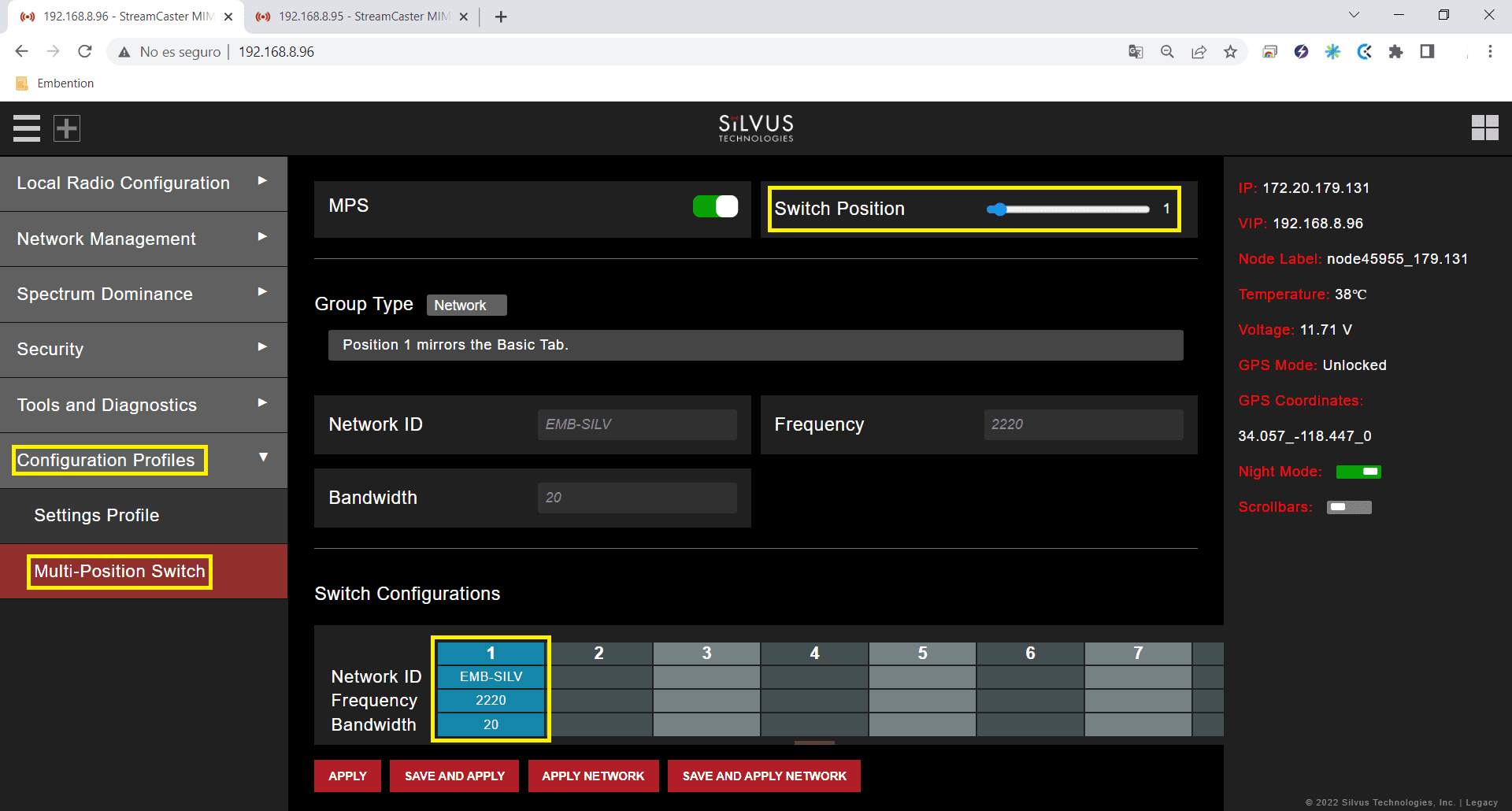
In this example only one configuration has been created.
With the above settings the configuration is finished. Furthermore, this configuration can be saved and downloaded in the Settings Profile window of the Configuration Profiles section.
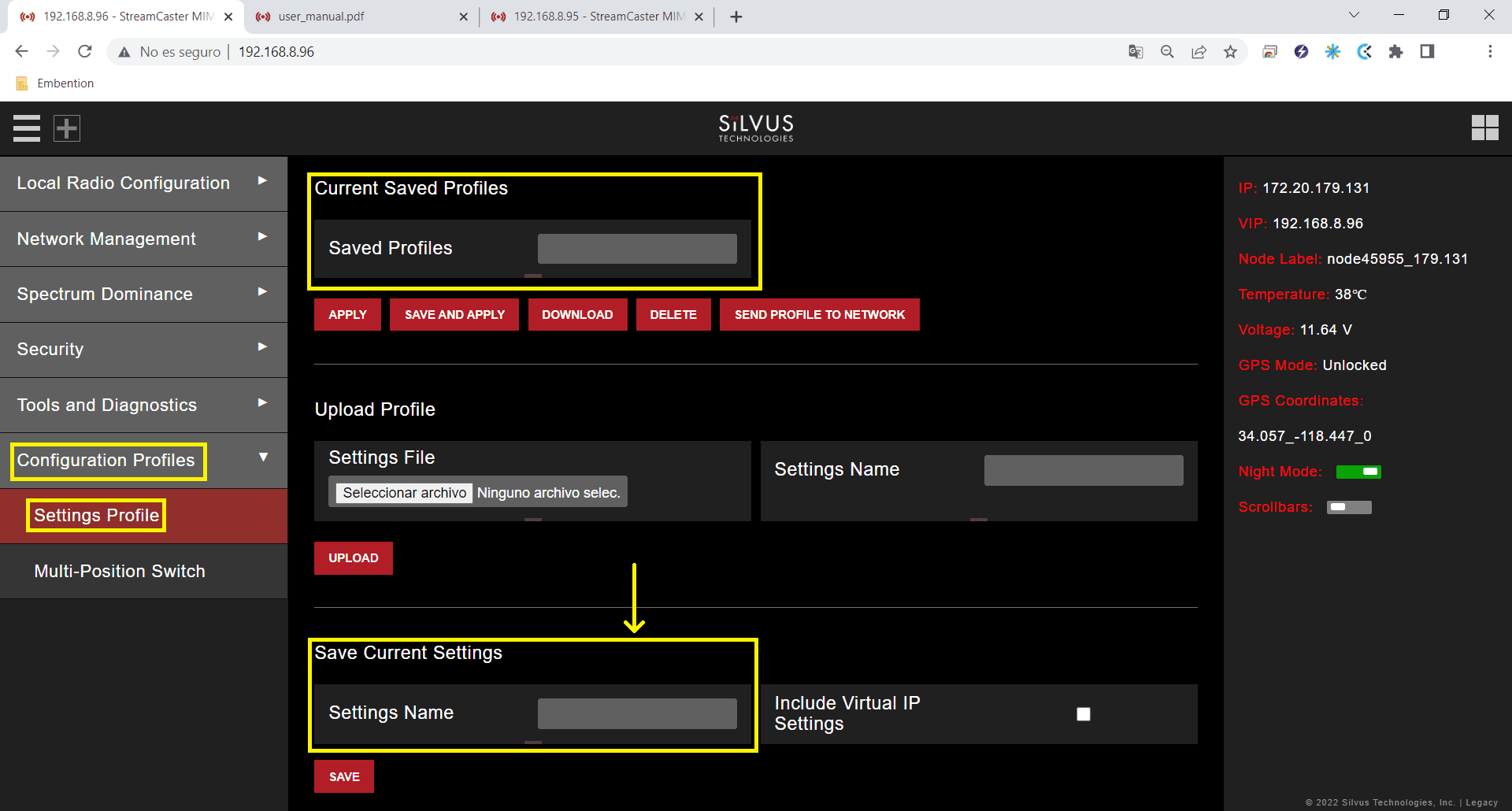
Before downloading the configuration, it is necessary to save it.
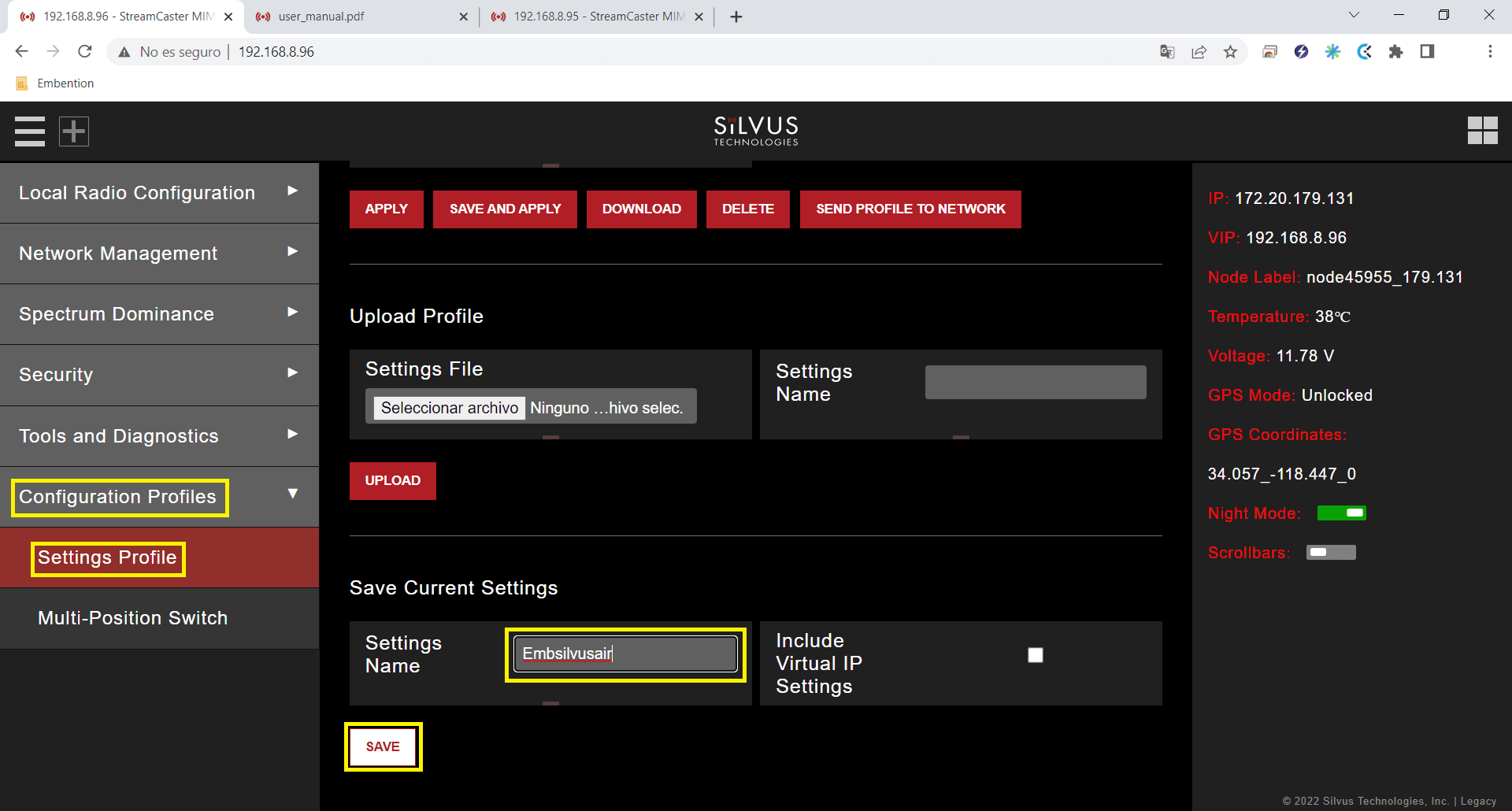
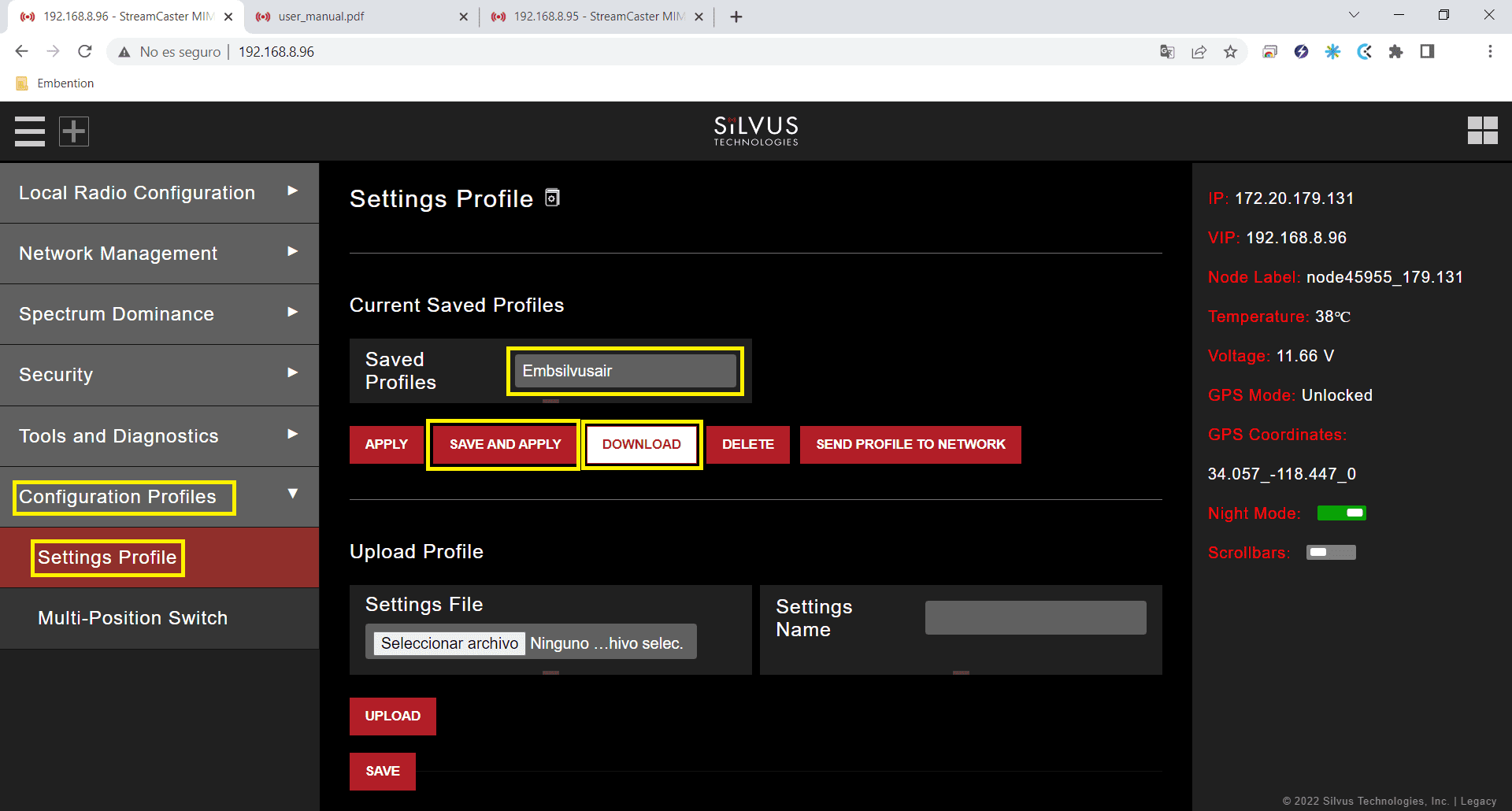
After configuring both radios with these settings they should be paired. Therefore, if we connect them to the power supply, when we switch them on, the LED will turn from fix red to fix green, this indicates that it is connected to at least one radio. Also, if we connect only one of them to the computer, we can access the StreamScape GUI of both.
And, in the Network Topology window of the Network Management section, we can see the link between them.
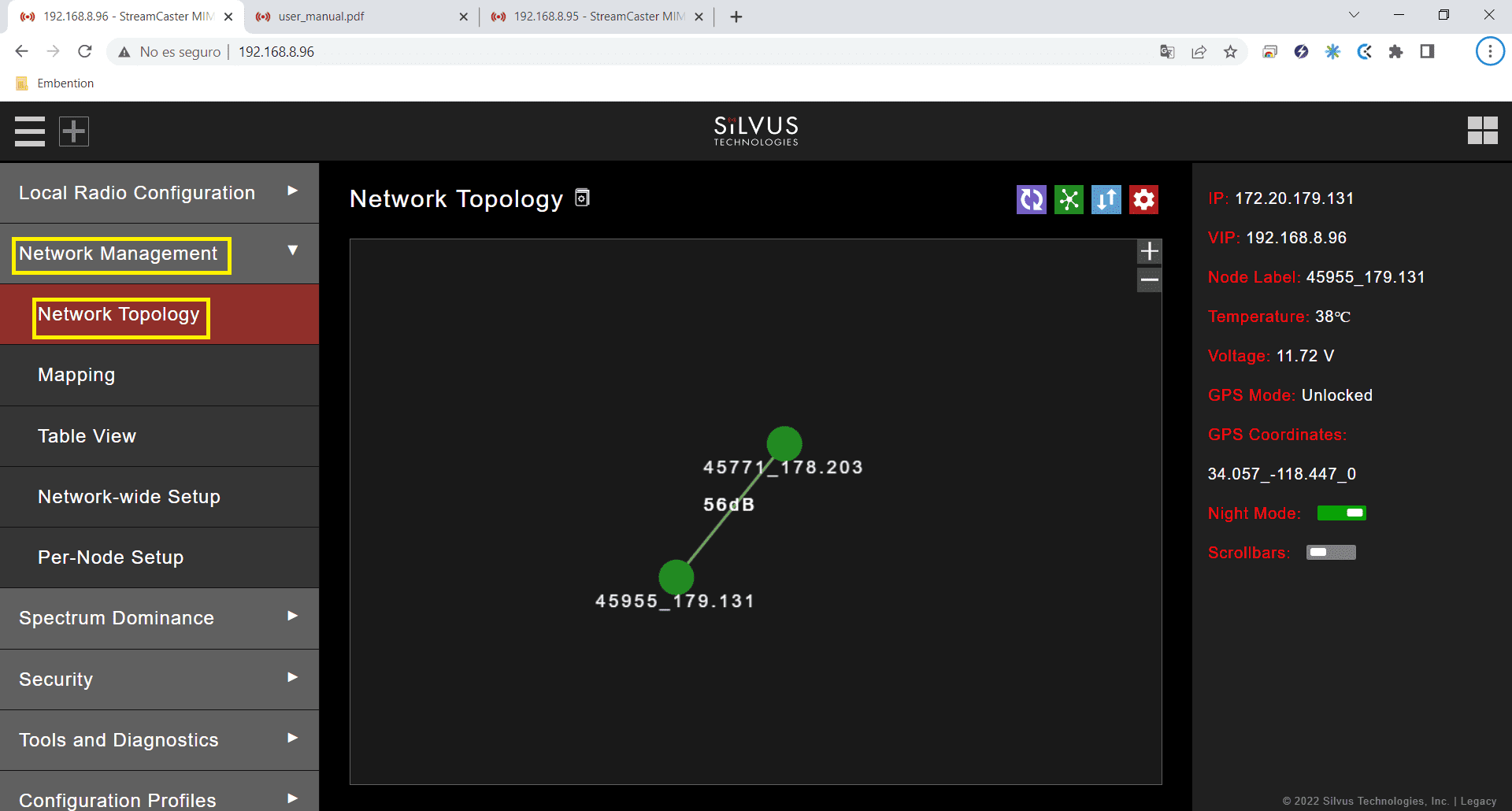
Silvus radio configuration in 1x PDI Builder
The necessary configuration of Silvus radio in 1x PDI Builder is described in the External radios - Integration examples section of the 1x PDI Builder manual.
Veronte SDL
SDL radio module has its own user manual, click here to read it.
This section shows how to connect and configure a SDL (any variant) with an Autopilot 1x air unit and an Autopilot 1x ground unit. The following diagram summarizes the flight communication system between a 1x ground unit and a 1x air unit installed on an aircraft.
First of all, Autopilots 1x and SDL require software configuration:
- To configure Autopilots 1x, use 1x PDI Builder by reading External radios - Integration examples section of the 1x PDI Builder user manual.
- To configure SDL, read the following sections of the SDL user manual:
- To know the basics and start configuring it: Software Installation.
- To configure according to the application requirements: Veronte Autopilot 1x - Integration examples.
Once all devices have been configured, the electrical connections can be established with the following figure, which shows the required connections according to 1x pinout, and SDL pinout.
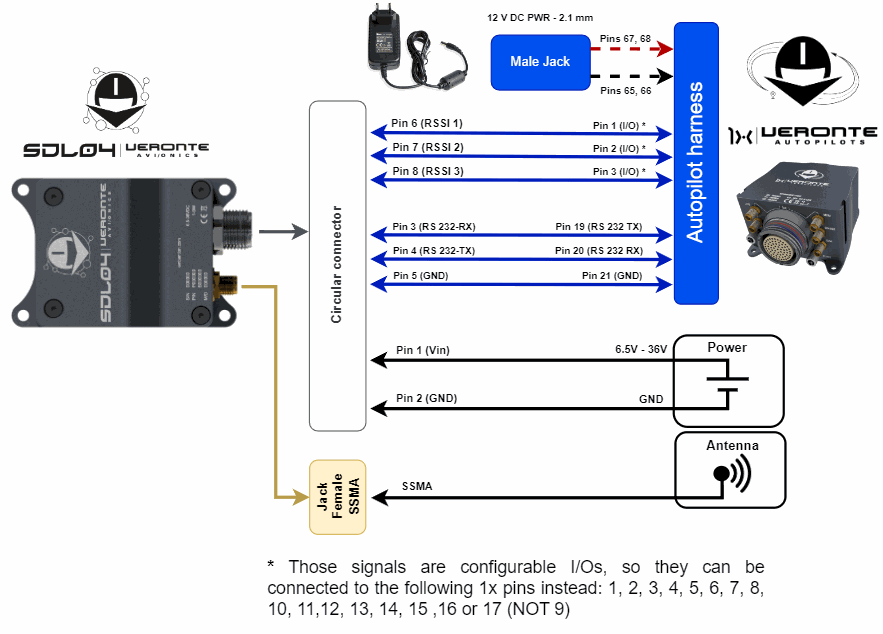
© 2025 Embention. All rights reserved.